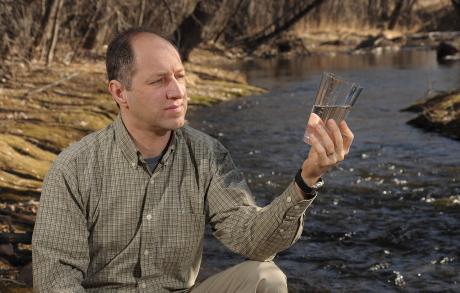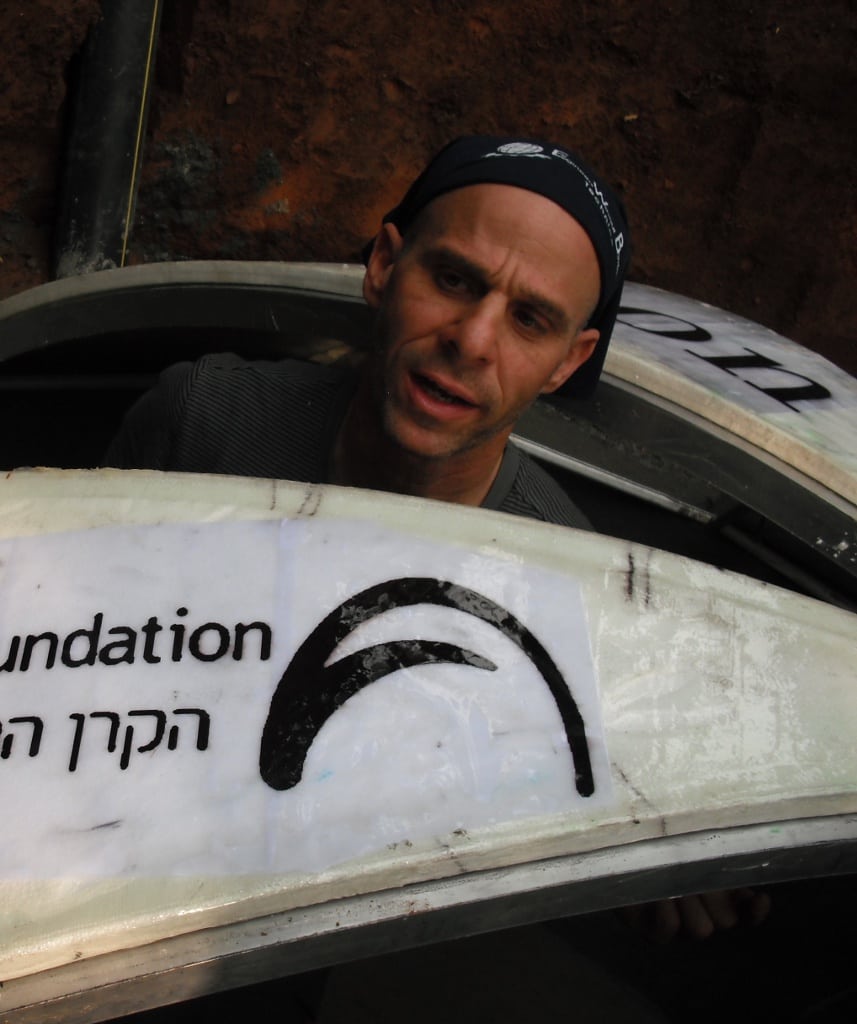The future of water treatment and sanitation may be on a schematic on a hard drive in Karl Linden’s lab at the University of Colorado in Boulder. The environmental engineering professor and his team develop the next generation of life-saving technology for developing countries and maybe everywhere else. In sanitation, Linden has led the development of the SolChar solar toilet that converts waste into biochar that can be safely applied to crop fields. The Gates Foundation awarded the project with two grants totaling $1.8 million in the Reinvent the Toilet Challenge. And in water treatment, Linden looks to ultraviolet disinfection, rather than the standard chlorination. UV treatment devices developed in his lab could serve as first-line community treatment and as emergency aid delivered after a natural disaster. We asked Karl Linden five questions.
E4C: You gave a talk at RMIT University in Melbourne called “Rethinking Disinfection in Drinking Water Systems,” and you asked the question, “If chlorine were discovered for the first time today, would it be an acceptable water treatment?” So, would it?
KL: I have a hard time imagining today’s public accepting the addition of a poisonous gas into our drinking water. Especially one that may form byproducts in the water that are known or suspected carcinogens. I wrote an op-ed piece in the Journal of Environmental Engineering (“Water Treatment Revolution” Feb 2007) a few years back where I argued that we spend so much effort engineering our systems to accommodate the use of chlorine – to make it more effective and also to minimize the guaranteed formation of disinfection byproducts – that we are missing opportunities to effectively treat our water in more sustainable ways.
However, you cannot be a self-respecting public health engineer/advocate without recognizing the incredible health advances society has enjoyed because someone had the ingenuity to think of adding chlorine to the water and saving millions of lives from deadly waterborne diseases back in the early 1900’s. Similarly, chlorine has a role in public health protection in the developing world today, being cheap and generally effective in many settings.
UV technology in general makes so much sense for disaster relief. It is very fast acting, is effective against all pathogens, and it is very mobile.
As an engineer who prefers to always challenge the status quo and ask why we do what we do and how can we think differently about persistent problems, it is clear that the acceptance of chlorine and effectiveness of this disinfection technique has major implementation problems in the developing world and elsewhere. The door is wide open for innovative thinking to move closer toward solving the problem of waterborne disease transmission.
E4C: SolChar has promise as a toilet that treats waste without the need for a sewage system or waste removal services, but it and other inventions in the Reinvent the Toilet Challenge have been criticized for their expense compared to the common composting pit latrine. So, is a toilet like SolChar practical in developing countries?
KL: The Reinvent the Toilet Challenge (RTTC) is a chance to think big and be creative. To push boundaries of what we think is possible. The vision that the Gates Foundation brought to this program was to let a bunch of people with interesting ideas loose, and provide them with the resources to literally “invent” new approaches to fecal sludge treatment. Billions of dollars are spent every year on water and sanitation projects in developing countries that eventually fail due to numerous reasons. Obviously the current system is not working to solve the sanitation problem world-wide anytime soon. To spend a few million dollars and allow 16 teams of some of the best researchers in the world to innovate in a space where major bottlenecks exist is bold and exciting. There is no doubt in my mind that the expense of the program is justified. And the spin-off research on topics like fecal derived biochar, odor control, and development of solar technologies we have engaged in just add to the impact on our field, whether or not you like SolChar. If you want to critique the Gates Foundation for being insensitive to public health improvements in the developing world based on the RTTC, then you just don’t know enough about all the other things they fund toward these ends.
The teams working on this challenge have developed some cutting edge solutions, but we all know how complicated the problems are, and no single technology can solve the sanitation situation. The SolChar toilet has numerous benefits but also major limitations. Being a solar based process it works when the sun is shining. It has expensive parts, relative to a pit latrine, such as a solar tracker, and bundles of fiber optics. It is shiny and could be attractive to thieves. We were fortunate to be able to prove our core innovative technology of concentrating solar energy, directing that energy via optical fibers to a heating chamber and achieving pyrolysis of human waste at temperatures up to 300 degrees Celsius. We did this starting from a 1 page concept note and in 15 months had a research prototype operating. From my perspective, that is incredible and could not have happened without an amazing team of researchers at CU Boulder. Check out www.colorado.edu/solchar.
Sometimes you go out on a limb with a vision… make it happen, and end up changing people’s lives. Sometime you don’t. But you keep trying.
Like any new invention, there is a long way to go to figure out how to make this technology operate efficiently and sustainably in a developing country setting and eventually make it marketable. While we have next generation designs that address many of the concerns for implementing our technology, we will not be piloting our technology in the field under the RTTC program, which is unfortunate. The level of public interest in our technology is high and its applicability to other issues such as heating and cooking are being explored through other funding venues. I can’t tell you the number of inquiries I have gotten from interested individuals who want one for their off-the-grid home. We are also actively exploring opportunities for applying our technology for waste treatment in remote public areas in more industrialized countries as well.
E4C: What new disaster response technologies might we see coming out of your lab in the next few years?
KL: One thing we are working on is application of UV-light emitting diodes for low power, remote, long-life, disinfection of water. We have three projects in this area and it is exciting to think about the possibilities. This work is funded by industry and the US EPA. We are working on solutions for small systems and personal point of use or point of entry applications. UV technology in general makes so much sense for disaster relief. It is very fast acting, is effective against all pathogens (chorine is not effective against protozoan pathogens), and it is very mobile. You can run UV off of small solar panels and monitor the process remotely. UV LEDs will enhance the application of UV in these settings even more.
E4C: In water and sanitation technology for use in developing countries, what is a dead end that people just won’t let die?
KL: That’s a loaded question. I can’t pinpoint any one technology or process that I think is dead. Things tend to die off on their own when they don’t work or people reject them. Personally, I am over the idea that NGOs can come in and make a difference in a one-off type application. It doesn’t matter what the technology is, if you don’t take the time to know a community, understand their needs in their unique setting, help develop local capacity and aspiration, and provide support in follow-up and creating a self-funded maintenance plan, I think that money is going to be wasted. Its donor-driven and it does not work. I have personally seen that some communities, when approached with a chlorine based solution to a water treatment problem, do not like the taste of the water and decide that they will just leave that part out when the implementer is no longer present. This is an instance of not understanding the cultural and societal preferences and trying to work within those bounds, or not implementing a robust enough behavior change program. Obviously that is going to be a major problem.
You solve one problem with a toilet in a peri-urban area, but you still have another major one to deal with. We need somewhere to take waste and get it treated so it is safe to handle and not harmful to the environment.
We tend to take small steps forward but problems still persist or new ones emerge. For instance we want to make sure people have access to improved sources of drinking water. Well those definitions of “improved” do not necessarily mean the water is safe to drink – we often just don’t know. So the numbers that show improvement in access to water may be misleading and underestimate the persistent need. We need more water quality information. On the sanitation side, while we are doing a better job focusing on removing waste from pit latrines and keeping that waste separate from human contact, we don’t have anywhere for the waste to be disposed of and it ends up polluting our environment and impacting human health. So you solve one problem with a toilet in a peri-urban area, but you still have another major one to deal with. We need somewhere to take waste and get it treated so it is safe to handle and not harmful to the environment.
E4C: Story time: Would you describe a time when you realized that you’re in the right line of work, doing something that matters?
KL: I feel fortunate that the career I have chosen to pursue has been extremely fulfilling to me. Its not just work for me but its my life, integrated into almost everything I do. The students who I work with, colleagues I enjoy meeting with regularly at conferences to share ideas and push each other intellectually, practitioners I interface with on projects who keep me grounded in reality, its all one big ecosystem and I try and keep it moving in a happy, positive direction. I am reminded all the time that my life and work has meaning and that helps keep me going. What could be better than teaching, learning, and discovering?
For instance, I mentioned the UV disinfection in developing countries symposium I helped organize, coming up in a few weeks. It was hard to know if we would get 10 or 100 attendees and if we could impact people in developing countries effectively through this knowledge sharing. Well, last week I got an email from my co-organizer Giuliana Ferrero at IHE-Delft forwarding me a note saying that the United Nations Youth Association of Nigeria is sending 9 people to the Netherlands to attend our UV symposium and network with the students, professors, professionals, and practitioners who will be there – that news made my day and I can’t wait to meet them all. We have about 70 people registered overall so it looks to be a very successful event, and growing. Sometimes you go out on a limb with a vision of an event like this, make it happen, and end up changing people’s lives. Sometime you don’t. But you keep trying.

